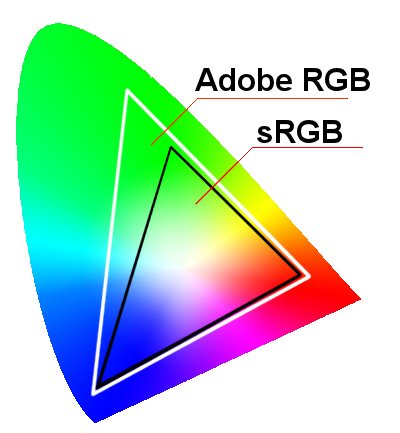Projector
Monitor
Lighting
Digital Display
Job References
Anyone who has had a middle school science class knows his name. It’s how we learned and remember the colors in the spectrum. When light passes through a prism or a rainbow appears after a thunderstorm, he’s there.

May I present to you: Roy G. Biv, the Rainbow Man. The Captain of Color. The man. The myth.
The acronym.Red
Orange
Yellow
Green
Blue
Indigo
Violet
Recreating the colors we see in nature is a challenge in graphic design work. It’s important in video production and gaming, too. If your eyes see red or green or blue you want your monitor to show them. Calibrating your LCD to present color-accurate scenes is an important first step, but how and where do you start? Fortunately, there are standards to go by.
Color Space

In the 1800s a British scientist and physician named Thomas Young had a theory about color and how the human eye sees it. His “wave theory of light” was built around the idea the eye had three types of cone cells, or photoreceptors, that could see either red, green or blue. Young proposed that, unlike Sir Isaac Newton’s belief that color was made of particles floating around, color was frequency, or wavelengths. The three main colors each had a unique wavelength, and different parts of the eye responded to these different wavelengths when light hit the retina, helping the brain interpret them as color. Blue had a short wavelength, green was medium, and red had a long wavelength. Young thought that all the colors the human eye can see were made up of combinations of red, green, and blue.
The German scientist Hermann Grassmann expanded upon Young’s work and developed the concept of color space. Grassmann’s Law said that all colors existed on an infinite dimensional scale, and each color was a point in that “space.” Grasmann’s Law explained how colors mixed from their red, green and blue origins.

Reproducing colors artificially and the methods used really depends on whether they are being presented on a color computer monitor or video display (digital) or printed on paper (analog).
Additive color mixing for digital displays results in an equal measure of red, green and blue, resulting in white. Subtractive color mixing for printing results in equal measures of cyan, magenta, and yellow to blend into black. Additive color mixing is called RGB, and it’s all about the type of light that must be emitted to display a certain color. Subtractive color mixing is known as CMYK, and it describes the type of ink that must be blended on a surface like paper or canvas to make light reflect a certain color. C is cyan, M is magenta, Y is yellow, and K is black in the CMYK model.
Think of it this way: White is the addition of all the colors in equal measure. Black is the other end of the scale from white and it’s a total absence of color.

Beware! Over-simplification ahead!
Obviously, printed matter existed long before video monitors did. When televisions and video monitors were invented, they were only capable of displaying a grayscale, with a variety of intensities from total black on one end to total white on the other. Everything in-between was a variation on gray, with more or less white or more or less black blended to produce an image. Color TV became widely available in the mid-1960s, and by the 1980s color computer monitors were on the scene. These color monitors used elements called phosphors to emit shades of color and reproduce what the human eye could see. Engineers wanted to produce the wide spectrum of color that was being displayed in the print shops. Since video screens emitted light, an RGB model had to be used. The RGB color model is an additive color model in which red, green and blue light are added together in various ways to reproduce a broad array of colors. To create and display a color with RGB, three light beams (one red, one green, and one blue) are stacked. The additive RGB color model combines the three light beams and their wavelengths are added together to display color and artificially show what the eye sees. The International Consortium of Color (ICC) created a standard to measure color monitors by and it was globally adapted for manufacturers.
In 1997, Adobe was working on a little application called Photoshop and trying to develop a standard for its color management functionality. Adobe wanted to make Photoshop compliant with the ICC standards, and since very few applications and computer operating systems had color profile standards, they created their own. In 1998, Adobe RGB was born. Adobe RGB was meant to create a standard across graphic design applications and computer monitors. People began to complain, though, when images created and edited in Photoshop looked “washed out” when viewed in a web browser. The problem was, the Adobe RGB standard wasn’t really…standard.
Hewlett Packard and Microsoft created a “standard” RGB color space that was designed to control consistent color values between computer monitors, in print, and in internet browsers. The color gamut, or range, of sRGB is narrower than Adobe RGB and brings the number of colors that can be created down so a wider variety of devices can display them. The wider color gamut present in Adobe RGB looks great on high-end displays, but lower quality ones just can’t reproduce that range and colors look desaturated and “washed out.”
It really boils down to this: There are standards in the industry that set the bar for performance. There are a lot of manufacturers out there with their own unique buzz words to describe what’s unique about their products. BenQ is on the leading edge of emerging imaging technology, and our products conform to the industry’s most stringent standards to ensure a best-in-class viewing experience.
BenQ Color Critical Monitors can display 99% of Adobe RGB, making them an excellent choice for photography and print design. As a factory default, BenQ monitors enable you to swap between Adobe RGB and sRGB color modes for the best of both worlds. Out of the box the BenQ Color Critical monitor is set to an sRGB profile. To use Adobe RGB, they must be calibrated. The BenQ Palette Master Element Software guides you through the process to ensure the highest performance.
Fine art and commercial photographer Mark Wood provides more detail in this BenQ Knowledge Base article. Roy G. Biv would certainly approve.